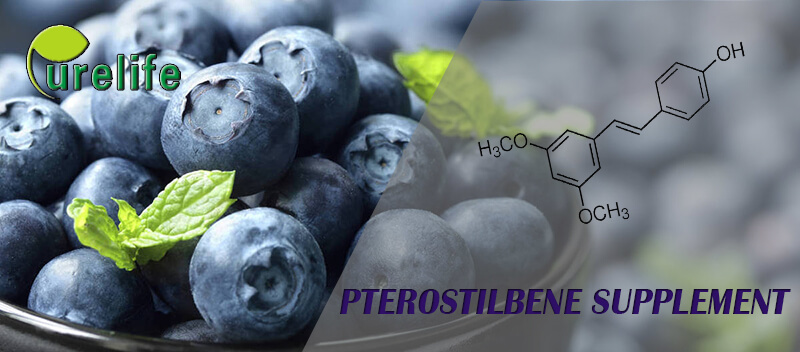Pterostilbene supplement
| Product Name | Pterostilbene |
| CAS number | 537-42-8 |
| Other names | 3′,5′-Dimethoxy-4-stilbenol; 3,5-Dimethoxy-4′-hydroxy-E-stilbene;4-[(E)-2-(3,5-Dimethoxyphenyl)ethenyl]phenol |
| Source | natural from Blueberry Extract; Synthesized from 3,5-Dimethoxybenzyl Bromide and 4-Nitrobenzaldehyde |
| Latin name | Vaccinium uliginosum L. |
| Molecular Formula | C16H16O3 |
| Molecular Weight | 256.30 |
| Specifications | 10%,20%, 50%, 99% pterostilbene |
| Appearance | white to off white powder/ white crystalline powder |
| Test method | HPLC |
| Benefits | Antioxidant, anti-cell proliferation, lipid and inhibit COX-1 and COX-2, anti-cancer, anti-fungal |
| Applied functions | Lowering blood lipids and cholesterol,Diabetes,Cognitive decline,Possible anti-cancer effects |

What is Pterostilbene?
Pterostilbene, according to Wikipedia, is a a stilbenoid, dimethylated derivative of resveratrol, and it is a chemical that can be found in many fruits, such as Pterocarpus marsupium, Anogeissus acuminate, Rheum rhaponticum, Peanuts , blueberries, cranberries and grapes. However, the most of the pterostilbene with high content is purely synthetic, not from natural sources.
Pterostilbene VS Resveratrol
Pterostilbene is a dimethylated derivative of resveratrol that, for some mechanisms, is more potent. It is also much better absorbed, and is commonly referred to as a ‘better resveratrol’. It looks promising, but has significantly less research than its predecessor.
Pterostilbene is one of many aromatic hydrocarbons called “stilbenes.” It’s a derivative of resveratrol, a compound found in large quantities in the skins of red grapes. Resveratrol burst on the health scene more than a decade ago, when it was found to have cardiovascular and cancer-fighting benefits.
Pterostilbene is a methylated stilbene molecule with structural similarity to Resveratrol, the only difference being two methoxy groups on the pterostilbene molecule that replace hydroxy groups on the resveratrol molecule. While most of the actions of the two are comparable, pterostilbene appears to be much better absorbed following oral ingestion and may be a more potent antioxidant and anticancer molecule.
You likely have heard of resveratrol – the incredible antioxidant contained in Polygonum cuspidatum, purple grapes and red wine that has shown promise in preventing disease as well as longevity studies. However, pterostilbene is more powerful than resveratrol.
Both resveratrol and pterostilbene belong to phytolexins the same family of compounds – stilbenes – and both contain plant chemicals called which fight infections. However, recent studies have shown pterostilbene to out-perform resveratrol in a few areas – notably improving mental functions, controlling blood sugar levels and improving heart health.
To begin with, pterostilbene is apparently more lipophilic than resveratrol – meaning it works with fat cells better. That characteristic makes it a more useable brain antioxidant as the brain consists of a higher percentage of fat cells than other tissue. In fact, pterostilbene was found in higher concentrations in both blood and brain tissue than resveratrol.
In addition, much more resveratrol is necessary to accomplish what pterostilbene does at a lower dose. One of the reasons for this is that resveratrol is cleared out of the body much more quickly, i.e., within 30 to 60 minutes of taking it. Studies have shown that resveratrol is rapidly metabolized by mammals and needs something to protect it during metabolism so all its great health boosting qualities are not lost.
Pterostilbene is absorbed more easily and is metabolized much more slowly than resveratrol. In this way, it is being thought of by researchers as a much longer-acting version of resveratrol. More and more research is suggesting that it may be much more beneficial for people to simply take pterostilbene on its own.
Why is Pterostilbene better than resveratrol?
Pterostilbene(methylated resveratrol) has greatly improved oral adsorption and metabolic stability. The enhanced activity of pterostilbene compared to resveratrol may, in part, be explained by structural differences. Pterostilbene with two methoxy groups and one hydroxyl group has improved lipophilicity and a higher potential for cellular uptake than resveratrol, which has three hydroxyl groups. Several published studies refer to pterostilbene as having better activity than resveratrol. For example, the result of one study indicates that pterostilbene is more effective than resveratrol as an inhibitor of DNA synthesis in the human adenocarcinoma HT-29 cell line. Additional, Rimando et al. have shown that unlike the related stilbenes resveratrol, piceatannol, nor resveratrol trimethylether, pterostilbene is a potent peroxisome proliferatoractivated receptor alpha agonist, lowering lipid levels in the blood stream at a higher rate than even ciprofibrate.
Therefore, the key advantages of pterostilbene over resvetatrol are:
Pterostilbene supplement is more powerful and effective than resveratrol in many ways:
Pterostilbene is better absorbed, and more biologically active
Pterostilbene is chemically and metabolically more stable and confers intended benefits without undergoing extensive metabolism as resveratrol
Pterostilbene supplement is more effective in inhibiting cell membranes against lipid peroxidation
Pterostilbene has been shown to better ameliorate dyslipidemia (in diabetic rats) thus contributing to supporting cardiovascular health
Pterostilbene supplement better reduces anti-inflammatory markers such as NFκB, iNOS and as a selective inhibitor of COX-2
Pterostilbene antimicrobial benefits are 5-10 times more powerful
Is there a difference between synthetic pterostilbene and natural pterostilbene?
Synthetic pterostilbene is nature identical, that is, it is the same as found in nature, both structurally and functionally. The main difference between synthetic pterostilbene or resveratrol and naturally-derived pterostilbene or resveratrol is the purity. Naturally derived compounds are extracted from the plants and concentrated to functional levels. During the process other naturally found and less desirable compounds are also concentrated. For example, concentrated resveratrol extracts also contain concentrated anthaquinones such as emodin which act as a natural laxative and can cause discomfort in sensitive individuals.
How Pterostilbene works
The Mechanisms of Action of pterostilbene is complicated. Pterostilbene owes its potential to diverse pharmacological actions that may alleviate diseases associated with oxidative damage and aging and promotion of health and an extended lifespan when used by healthy individuals. In general terms, the pharmacological actions of trans-pterostilbene are anti-inflammatory, antineoplastic and antioxidant; these activities stem from biological interactions at a fundamental level for both control of gene expression and enzyme activity modulation.
Pterostilbene possesses potent, concentration-dependent, antioxidant effects. It is becoming increasingly clear that the specific pharmacological activities attributable to individual natural stilbenes are governed by the unique structural differences that distinguish them. For example, resveratrol (with three hydroxyl groups) neutralizes reactive oxygen species (ROS) in whole blood and isolated lymphoblasts, whereas pinosylvin (with two hydroxyl groups) influences mainly intracellular ROS; pterostilbene (with two methoxy and one hydroxyl group) reduces extracellular ROS. This localization of antioxidative effect allows the use of pterostilbene to target extracellular reactive oxygen species that are, among other things, responsible for tissue damage during chronic inflammation.
Benefits of taking Pterostilbene supplements
Based on animal studies done with pterostilbene, it has been shown to have the following health boosting properties:
Anticancer – high antioxidant properties means higher protection against DNA and telomere damage. Shown also to have an inhibitory effect against a form of cytochrome P450, an enzyme that activates “procarcinogens” that turns toxins (cigarette smoke and pesticides into cancers). Specifically, studies show that pterostilbene may be beneficial in fighting breast, digestive and colon cancers.
Anti-inflammatory – inflammation leads to many diseases. Antioxidants like pterostilbene reverse inflammation.
Anti-high cholesterol, high triglycerides – animals fed blueberries were found to have lower blood levels of lipids and cholesterol. Reported to be more effective than some cholesterol lowering drugs.
Fights cognitive decline – animals fed pterostilbene containing blueberries showed significant reversal in mental decline from aging versus strawberries and spinach.
Normalized blood sugar and insulin levels – antidiabetic. Effects reported are similar to the drug metformin in optimizing insulin output/usage.
Side effects of taking Pterostilbene supplement
When researching this supplement it is unlikely that you will find much information regarding side effects. That is because there are not any known side effects of this supplement. It is still prudent to only start with a low dose and work up from there, but it is incredibly safe and there is low risk of any negative outcomes.
Dosage of taking Pterostilbene supplement
While there is no Recommended Daily Intake (RDI) for pterostilbene supplement, the current science supporting the product suggests a daily dosage of 100 to 250 mg. A single 50 mg to 125 mg capsule taken twice daily is recommended for all adults.
Where to buy high quality Pterostilbene?
Purelife bio is a professional and reliable supplier of raw material of Pterostilbene with NLT 98% purity by HPLC. If you need certificate of analysis of Pterostilbene, MSDS, pricing quotation, test spectrum or have any other technical questions, please kindly drop us an email at info@purelife-bio.com, a timely and professional support will be provided upon your request.
And raw Pterostilbene powder is available in our USA warehouse as well.




